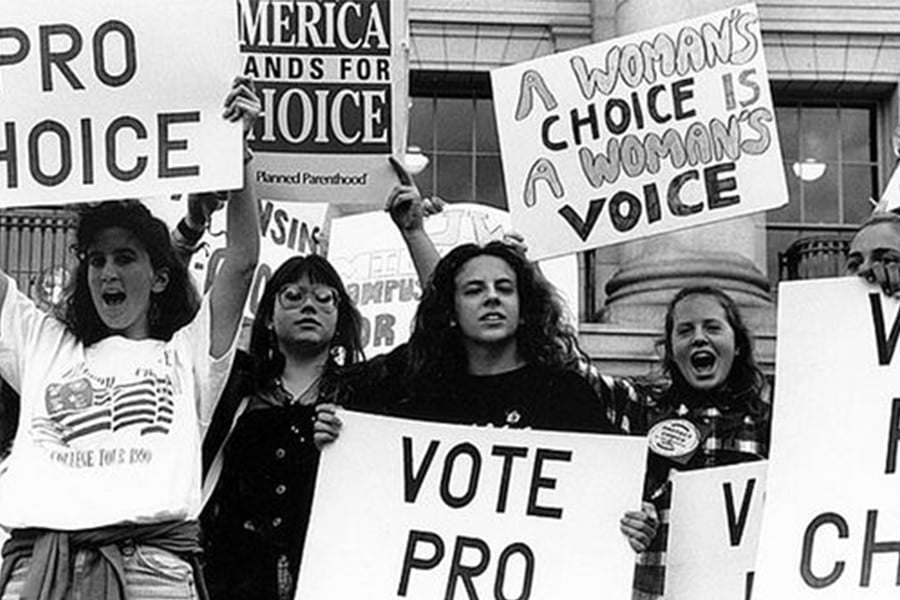
Our fears have been realised. A leaked draft ruling published by Politico reveals the US Supreme Court's desire to turn back the clocks on Roe vs. Wade. The landmark 1973 decision enshrined the right to abortion in constitutional law and its absence will undoubtedly have devastating consequences for women across the US. For those wishing to learn more about the draft and its threat to reproductive rights, we've brought you 5 things to know about the document below.
1. What actually is Roe vs. Wade?
Most of us understand that Roe vs. Wade was a crucial moment in advancing abortion rights in the US, but we'd forgive you for not knowing why or what the case was about. So before we launch into what's at stake if Roe vs. Wade is overturned, let's dig into the specifics of the landmark Supreme Court ruling.
At the heart of the case is the then-22-year-old Texan plaintiff named Norma McCorvey who went by the pseudonym Jane Roe. Wade comes from the name of the defendant Henry Wade, a Dallas County district attorney at the time. In 1970, McCorvey sued the state of Texas for her right to terminate a pregnancy.
When McCorvey's case was first heard, Texas Law stipulated that abortion was illegal unless carrying the foetus to full-term proved life-threatening to the mother. In 1973 McCorvey finally appeared before the Supreme Court, after years of legal challenges and appeals bolstered by the women's rights movement who recognised the potential of the case to legalise abortion. The Supreme Court judges ruled by a 7-2 majority that the Texas law was unconstitutional on the grounds that it breached a women's right to privacy and was too vague. Thus enshrining the right to abortion in the US constitution up until the period of foetal viability, which has since shifted from 28 weeks to 22-23 weeks thanks to advances in medicine.
Roe vs. Wade immediately struck down laws that made abortion illegal in several states and in recent years conservatives have grown more organised in their wish to see Roe vs. Wade overturned. It's a pursuit inflamed by Donald Trump's tenure as US president and viewed as more viable following Trump's appointment of three Supreme Court justices, namely Neil Gorsuch, Brett Kavanaugh and Amy Coney Barrett. As a result conservatives now hold the majority vote in the Supreme Court.
2. What is the draft ruling and why is it a big deal?
On May 2, Politico published a story containing a leaked draft from Supreme Court Judge Samuel Alito indicating plans to overturn the Roe vs. Wade ruling. At the time of writing, 5 of 9 justices have responded in the affirmative of the draft, them being Clarence Thomas, Neil Gorsuch, Brett Kavanaugh and Amy Coney Barrett. As a result, conservatives have secured a majority vote in the Supreme Court, confirming the fears of all who were opposed to the latter three justices being appointed to the Supreme Court. The document is noted as having been circulated among the justices on February 10.
Justice Alito states in the draft that, “Roe was egregiously wrong from the start". He furthered, "its reasoning was exceptionally weak, and the decision has had damaging consequences. And far from bringing about a national settlement of the abortion issue, Roe and Casey have inflamed debate and deepened division".
The draft ruling is in response to the high profile case, known as Dobbs v. Jackson Women's Health Organization. Filed in March 2018, the case is currently before the US Supreme Court whereby the state of Mississippi wishes to ban most abortions after 15 weeks of pregnancy. A final decision is not expected to be issued until June or early July according to The New York Times.
3. An investigation has been launched to find out who leaked the documents
Naturally, this news has not been received well globally by women and allies, and a protest began to brew outside the site of The Supreme Court upon the news breaking. Somewhat equally as angry is Chief Justice Roberts who has ordered an investigation into the source of the leaked documents, dubbing it a "betrayal of the confidences of the Court". Unlike other major institutions, The Supreme Court has mostly avoided large leaks such as these.
“This was a singular and egregious breach of that trust that is an affront to the Court and the community of public servants who work here,” Chief Justice Roberts continued in a statement issued by the court.
Within that same statement, Chief Justice Roberts confirmed that Justice Alito's draft was in fact, real. Although he was careful to emphasise that a final decision was yet to be made and the positions of each justice could very well change.
While one would imagine republicans would be rejoicing at the news of being so close to a decades-long campaign against abortion rights, many are furious, seeing the leak as an attempt to intimidate the court into an alternative decision.
4. What do abortion rights currently look like in the US?
As it stands, abortion rights vary from state-to-state, with at least one clinic in each state performing the medical procedure.
According to NBC News, in 2021 nearly 600 anti-abortion laws were introduced across 47 states. One of the strictest, outside total bans from Oklahoma and Arkansas, being a Texas law that prohibits abortion once cardiac activity is detected in the baby, so around 6 weeks. At this stage in a pregnancy, many women don't even realise they're pregnant, making it near impossible for them to access the medical procedure in a safe and timely manner.
Meanwhile, although at present still unconstitutional, anyone who provides or attempts to provide an abortion in Arkansas can face up to 10 years prison time and fines of up to $100,000. This bill doesn't allow exceptions for rape or incest and was signed by Governor Asa Hutchinson because of “overwhelming legislative support and my [his] sincere and long-held pro-life convictions".
5. How will they change if Roe vs. Wade is overturned?
If Roe vs. Wade is overturned, states will have the power to design their own approach toward abortion. According to the BBC, this means an estimated "36 million women of reproductive age would live in states without abortion access". As research has always shown, poor women and women of colour are the greatest affected by making abortion illegal let alone inaccessible.
There are 13 states that have 'trigger' laws in place that would immediately make accessing abortion illegal if Roe vs. Wade was overturned. These states are as follows: Arkansas, Idaho, Kentucky, Louisiana, Mississippi, Missouri, North Dakota, South Dakota, Tennessee, Utah, Texas, Oklahoma, and Wyoming.
Meanwhile, other more progressive states are moving quickly to prepare for a world without the protection of Roe vs. Wade. Governor Gavin Newsom of California called for a state constitutional amendment, saying “we are going to fight like hell".
Needless to say, this is truly a bleak and scary time to be a woman in the world.
Image: Pinterest



